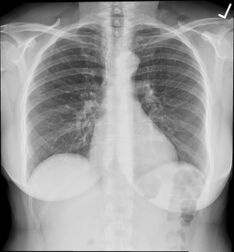Sciagraphy and fluoroscopy
(Redirected from Fórum:Seminární práce/Biofyzika/2. LF)
Sciagraphy and fluoroscopy[edit | edit source]
General description[edit | edit source]
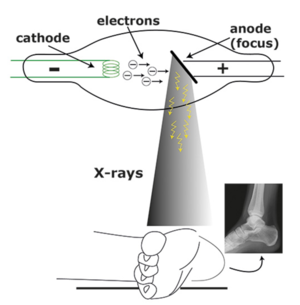
Sciagraphy is the art, science or act of depicting or projecting shadows. In medicine skiagraphy refers to a diagnostic method, which uses X-rays for projection of soft and hard human tissues. It is based on the capability of tissues to absorb radiation, different tissues in the human body absorb a beam of X-rays at different rates. The resulting image is captured on a sensitive material – photographic film or digital detector. The radiograph enables us to predict internal structure or injury of observed organ. This method is most frequently used to examine bones, teeth or joints. However, it can be also used to project soft tissues such as muscles or lungs. Output of a sciography is a physical X-ray or digital X-ray uploaded to the computer. Sciagraphy is typically the first imaging method used to evaluate the condition of the patient.
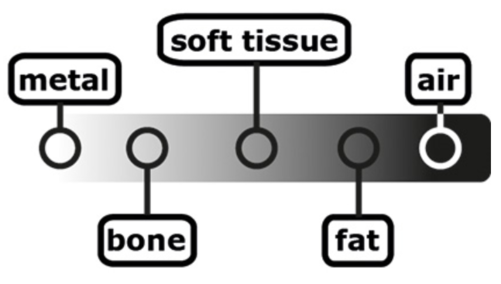
Methods of imaging[edit | edit source]
In order to create two-dimensional image, two projections are usually made – one anterior-posterior and one lateral. Creating two-dimensional X-ray /Radiograph/ allows us to observe the spatial configuration of projected structures. Radiographs of chest are an exception, because posterior-anterior projection is preferred instead of anterior-posterior. This is done because body parts closer to the source of X-ray are magnified, in anterior-posterior projection heart would be closer to the source of X-ray. Magnified heart in the X-ray scan could lead to inaccurate diagnosis. It is of a great importance to label the radiographs with letters R or L /which stand for right/left side/ and signofot with the basic information concerning the patient. X-rays pass through the human body. As it happens some of the radiation is absorbed /the rate of absorption depends on the density of the structure/ allowing us to capture the projection on sensitive RTG films. Special X-ray films with emulsion layer containing higher amount of AgI are much more sensitive and therefore produce better contrasted X-rays. Produced image is a negative, by using contrast and brightness specific structures can be identified. Brighter spots represent structures which absorb more radiation, while on the other hand, dark spots are anatomies where X-rays are absorbed at the lowest rate. Negatoscope (device for displaying X-ray film) is used for evaluating the X-ray films.
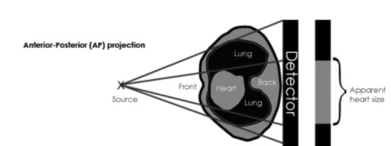
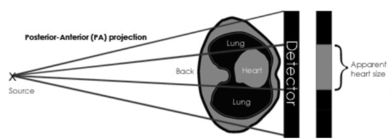
Imaging of different tissues[edit | edit source]
There are several types of X-rays tubes with various voltage. When producing X-ray of hard tissues or lungs, X-ray tubes with voltage higher than 100kV are used, on the contrary X-ray tubes with voltage lower than 45kV are required for X-ray of soft tissues (breast).
Grid[edit | edit source]
In order to reduce the quantity of scattered photons it is necessary to use filtration and shielding of X-ray beam. Primary filter (grid) absorbs low-energy photons and is therefore placed near the X-ray tube. Secondary filters such (stationary Lysholm’s grid with very thin lead strips or moving Potter-Bucky grid) are placed between the patient and the X-ray detector, where they trap the scattered photons and enhance the quality of X-ray scan.
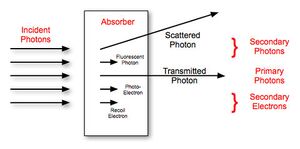
Types of radiography[edit | edit source]
The conventional radiography as the name suggests uses X-ray films with sensitive emulsion to produce an image. The image is a two-dimensional projection of a three-dimensional object. On the other hand, digital radiography uses x-ray sensitive plates to capture the data. Captured data are then immediately transferred to the computer, where they can be examined by the radiologist. Digital radiography comes with several advantages, the most significant would be time efficiency and the fact that less radiation is required to produce an image of comparable quality to conventional radiography. However, digital X-ray machines are considerably more expensive, which might create an obstacle for many medical facilities.
Radiocontrast agent[edit | edit source]
Examination is done more easily when using radiocontrast agent, which enhances the visibility of projected tissues. Radiocontrast agent can alter the ratio at which the radiation is absorbed in the human body, creating variations in the transparency of the examined tissues compared to the organ or surroundings. Radiocontrast agents can be further divided into two categories:
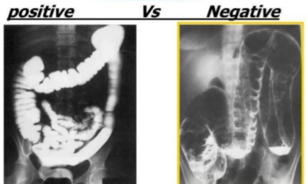
1.Positive radiocontrast agent[edit | edit source]
-Substances with high proton number and high absorption ability, forming a dense shade in the X-ray film.
-There are two types of positive radiocontrast agents:
A. Iodine based radiocontrast agents are usually of a liquid form (organic iodine molecules in water solution) administrated intravenously. They are widely used in angiography or lymphangiography.
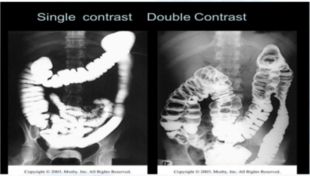
B. Barium based radiocontrast agents contain barium sulfate (insoluble in water) and are administered directly to the gastrointestinal tract because they are used in imagining of digestive system.
2.Negative radiocontrast agent[edit | edit source]
-Substances that absorb the radiation in lower quantities than examined tissue, they are therefore used in order to brighten the X-ray. Examples of negative radiocontrast agents are air, CO2, N2O.
-Method of double contrast: when examining the digestive tract, both positive and negative radiocontrast agents are used at the same time.
Contraindication[edit | edit source]
Condition, factor, specific situation in which a treatment, drug, method of examination is withhold because it may be harmful to the patient. In this case X-ray is withhold in first four months of pregnancy because the radiation could harm the fetus.

Fluoroscopy[edit | edit source]
Fluoroscopy is a diagnostic, interventional radiology method that uses dynamic X-ray (real-time moving) projection. It is used widely in examinations of the peristaltic movements of oesophagus, stomach, intestines or examinations of breathing movements and pumping action of the heart. In order to lower the radiation doses a momentary pulse is generated for example four times per second (so is the projection) and not continually as it is done while using the radiography method. Radiocontrast agents (described in skiagraphy part) are often used in order to enhance the quality of produced X-ray.
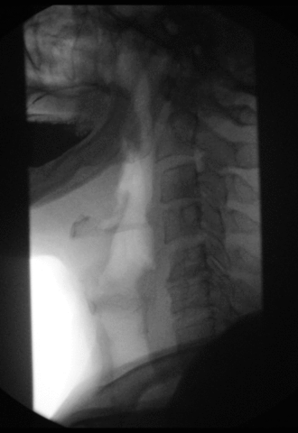
Sources[edit | edit source]
- https://www.wikiskripta.eu/w/Skiaskopie https://www.wikiskripta.eu/w/Skiagrafie NAVRÁTIL, Leoš a Jozef ROSINA, et al.
- Medicínská biofyzika. 1. vydání. Praha : Grada, 2005. 524 s. ISBN 80-247-1152-4. JOSEF NEKULA, Miroslav Heřman, et al.
- Radiologie. První vydání. Univerzita Palackého v Olomouci, 2001. 205 s. s. 12–13. ISBN 80-244-0259-9. SVOBODA, Milan.
- Základní techniky vyšetřování rentgenem. Druhé vydání. AVICENUM, zdravotnické nakladatelství, n.p., 1976. 604 s. s. 79-87. ISBN 08-013-76.
- https://en.wikipedia.org/wiki/Fluoroscopy
- https://www.hopkinsmedicine.org/health/treatment-tests-and-therapies/barium-swallow
References[edit | edit source]
- ↑ https://www.radiologymasterclass.co.uk/tutorials/physics/x-ray_physics_beam
- ↑ https://www.radiologymasterclass.co.uk/tutorials/physics/x-ray_physics_beam
- ↑ https://www.radiologymasterclass.co.uk/tutorials/physics/x-ray_physics_beam
- ↑ https://www.radiologymasterclass.co.uk/tutorials/physics/x-ray_physics_beam
- ↑ https://en.wikipedia.org/wiki/Bucky-Potter_grid
- ↑ https://www.slideshare.net/MohammadNaufal2/basics-of-contrast-media
- ↑ https://www.slideshare.net/MohammadNaufal2/basics-of-contrast-media
- ↑ https://en.wikipedia.org/wiki/Fluoroscopy
- ↑ https://en.wikipedia.org/wiki/Fluoroscopy

